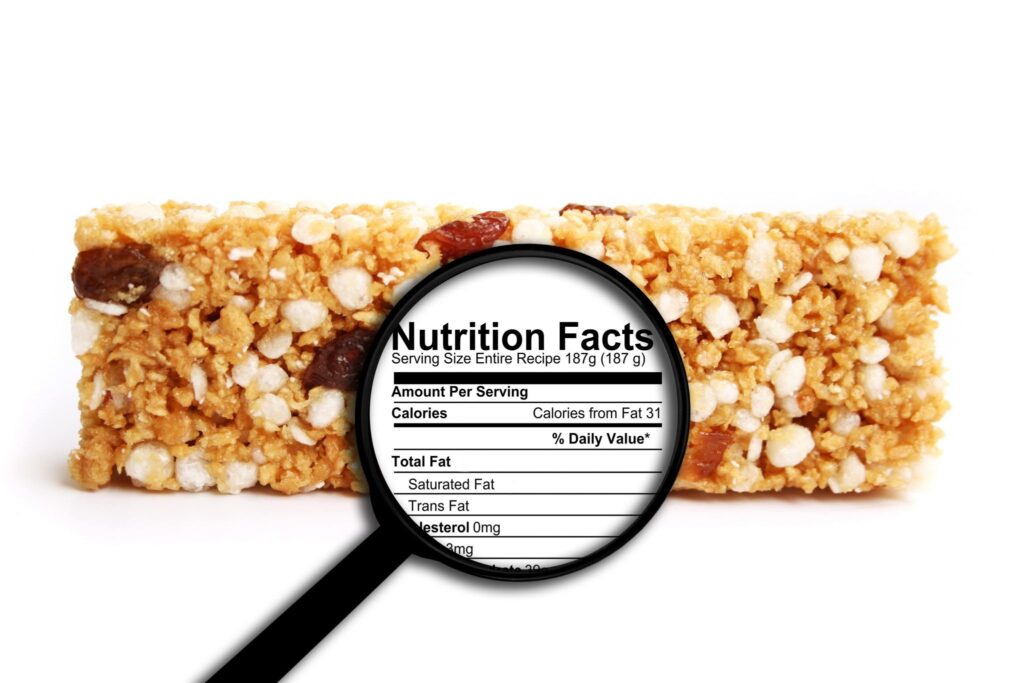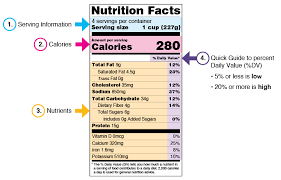
All packaged foods come with a nutrition label meant to provide us with the information necessary to know exactly what we are eating. Understanding what’s in the food we eat helps us make healthier choices. Checking food labels also makes it easy for us to compare the nutrient content of different options. A healthy diet is crucial throughout our lifetime and paying attention to nutrition labels is a good step toward improving our overall diet.
There are some amazing benefits of reading nutrition labels-
- It provides information that’s vital for our diet.
- It helps us plan our diet well if we are suffering from health conditions like diabetes, high blood pressure, etc.
- It can help us identify the ‘sugar’ content.
- It helps us understand the calories per serving.
- It helps us keep a tab on bad fats.
Step 1: Start with the serving size

- Here look for both the serving size and the number of servings in the package. It may be given as the number of servings per container/ packet or the weight/ volume in g/ ml.
- The nutrition facts label information is generally based on one serving/ per 100 g /100 ml, but many packages may contain more than one serving or more than 100 g or 100 ml.
- Look at how many servings/ g/ ml you are consuming. If there are two servings/ 200 g/ 200 ml in one packet and you eat the whole packet, you have consumed double the calories and nutrients mentioned in the nutrition facts.
Step 2: Check out the total calories
A calorie is basically a measure of energy i.e. how much energy will this food give us.
- Now some food packets say ‘calories’, some say Kilocalories (Kcal) – don’t get confused -these are all the same. Kilocalories is not 1000 calories; it is one calorie.
- If the packet contains two servings and the calorie content is 100 calories per serving then you consume 200 calories if you eat the whole packet.
- Decide what your calorie requirement is, what your fitness goals are, and then always calculate what percentage of your daily calorie quota will go away by eating this food.
Step 3: Let the percent daily values (% DV) be a guide

- Daily values are the reference amount of nutrients to consume or not to exceed and are used to calculate the daily value percentages on the label.
- This can help the consumer use the nutrition information in the context of a total daily diet.
- Use percent Daily Values to help evaluate how a particular food fits into your daily meal plan. % DV are for the entire day, not just one meal or snack. Daily Values are average levels of nutrients for a person eating 2,000 calories a day.
- A food item with a 5% DV of fat provides 5% of the total fat that a person consuming 2,000 calories a day should eat.
- You may need more or less than 2,000 calories per day. For some nutrients, you may need more or less than 100% DV. Keep in mind that every person’s nutrient needs are different.
- Low is 5% or less. Aim low in saturated fat, trans-fat, cholesterol, and sodium.
- High is 20% or more. Aim high in vitamins, minerals, and fiber.
Step 4: Consider carbohydrates
- Carbs are the basic energy blocks of the body and as the name suggests they are made of carbon as in ‘carbo’ and water as ‘hydrates’. One gram of carbohydrates has four calories.
- There are three types of carbohydrates: sugars, starches, and fiber.
- Check for sugars, especially added sugars. The Dietary Guidelines by The National Institute of Nutrition (NIN) recommends consuming no more than 10% of daily calories from added sugars. Limit sugars especially added sugars, to reduce your risk of obesity. Eating too much added sugar makes it difficult to meet the nutrient needs within your calorie requirement.
- Check the amount of fiber. Fiber improves digestive functioning and overall health.
Step 5: Consider proteins
- Look for foods that are rich in proteins. Proteins are the building blocks of our body. They are found in muscles, bones, hair, skin, and tissues and are important for the body to function properly. Proteins also provide energy (4 Kcal/g).
- Protein requirements vary with age and physiological status.
Step 6: Consider fats & cholesterol:
- Fats are a concentrated source of energy providing 9 Kcal/g, and are made up of fatty acids in different proportions.
- To help reduce your risk of heart disease, use the label to select foods that are lowest in saturated fats, trans-fats, and cholesterol.
Step 7: Get enough vitamins and minerals
- Select foods that are rich in a variety of vitamins and minerals as they help us fight infections and keep us healthy.
- Eat more potassium, vitamin D, calcium, and iron to maintain good health and help reduce your risk of certain health problems such as osteoporosis and anemia.
- Remember to aim high for % DV of these nutrients.
- Choose low in sodium. High levels of sodium can add up to high blood pressure. So, remember to aim for a low % DV of sodium.
IMPORTANT NOTES
Don’t let marketing gimmicks fool you. Low-fat, fat-free, sugar-free, cholesterol-free, calorie-free, sodium-free, low- sodium… the market is flooded with products specifically aimed at attracting the growing tribe of health enthusiasts. And while it’s great to have options, it’s equally important to verify these claims are true.
Here’s a quick guide to shopping right…
Calories:
As per the FDA, 40kcal per serving is low in calories, 100kcal is moderate and 400kcal is high.
Sodium:
Less than 5mg is considered sodium-free, while lesser than 140mg is considered low sodium.
Sugar and HFCS:
Sugar, either in its natural form or otherwise (high fructose corn syrup, fructose syrup, golden syrup and the like) should be noted on the label. High sugary foods not just include chocolates and candies, but even certain breakfast cereals, aerated drinks, milkshakes, energy bars, low-fat yogurt and fruit juices. Less than 0.5gm of sugar per serving is considered sugar-free.
Cholesterol/saturated fat:
Cholesterol free should mean less than 2mg cholesterol and 2gm or less saturated fat. Be cautious about both saturated and trans fats as they are harmful for your heart health.
Anti nutrients:
Food additives and color’s are added in minute quantities but could be harmful. According to some studies, color’s like blue 1, blue 2, yellow 5 and caramel color could cause cancer, brain damage and tumor.
Refer to this table for more clarity…
| LABEL CLAIM | DEFINITION (per standard serving size) |
| Fat-free or sugar-free | Less than 0.5gm of fat or sugar |
| Low fat | 3gm of fat or less |
| Reduced fat or reduced sugar | At least 25% less fat or sugar |
| Cholesterol free | Less than 2mg cholesterol and 2gm or less saturated fat |
| Reduced cholesterol | At least 25% less cholesterol and 2 g. or less of saturated fat |
| Calorie free | Less than 5 calories |
| Low calorie | 40 calories or less |
| Light or lite | 1/3 fewer calories or 50% less fat |
| Sodium free | Less than 5mg sodium |
| Low sodium | Fewer than 140mg sodium |
| High fiber | More than 5gm of fiber |
The Food Label is designed to help people choose foods well. It is crucial to determine your nutrition goals first so that you can make the best use out of food labels. By knowing how to use it, we can understand how a specific food item can fit into our overall diet. This can help us select foods and choose between products more effectively and efficiently. So, go ahead, check the label, and manage your health better.
To get a detailed guidelines or a personalized plan for your health problems you can contact directly, In the pandemic my online consultations are on Contact details mentioned below, Happy to help always.
Be Happy Be healthy.
